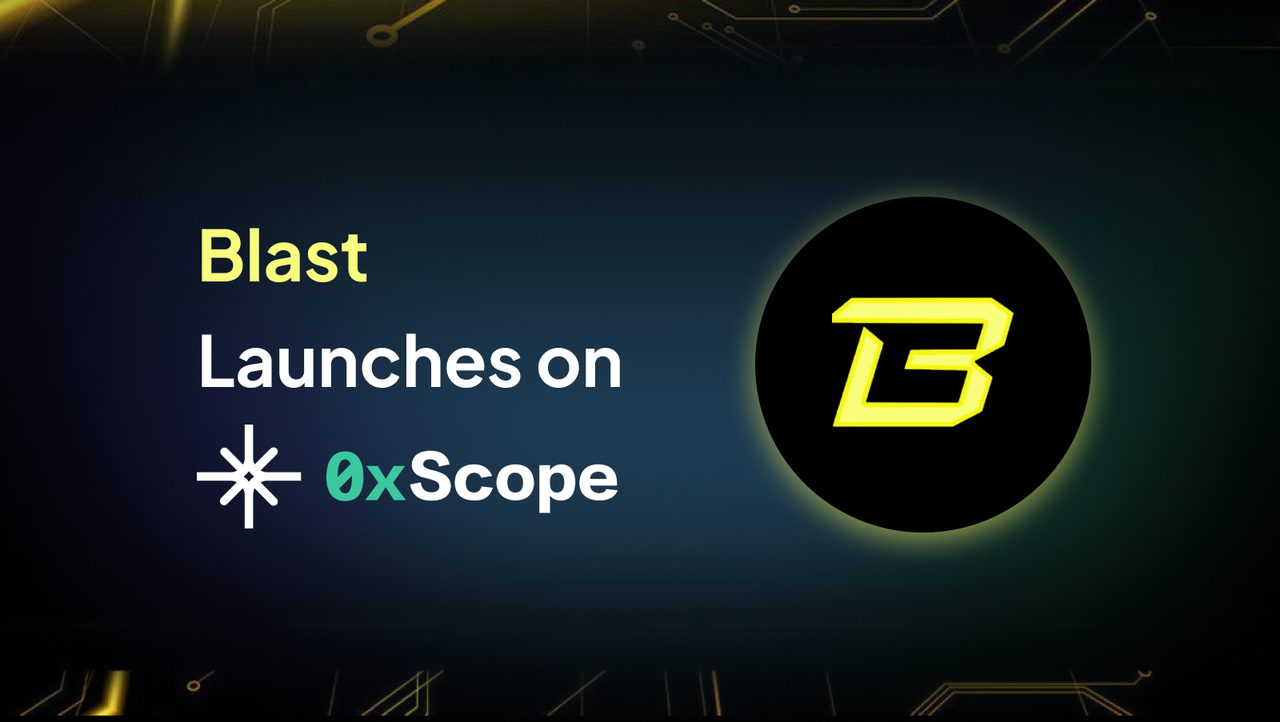

Blast Launches on 0xScope

0xScope has recently launched support for Blast, an Ethereum Layer-2 scaling solution from the team that created NFT marketplace Blur, on Scopechat and Scopescan.
Blast sets itself apart from other L2 solutions in the Web3 market thanks to its introduction of native yields for $ETH and stablecoins like $DAI, $USDC, and $USDT. In effect, Blast is the only Ethereum L2 with an innate passive income mechanism thanks to its native yield feature.
In this article, the 0xScope team provides an overview of key statistics and important trends related to the Blast ecosystem.
Brief History of Blast
Blast, an EVM-compatible Optimistic rollup, was introduced in November 2023 by a development team led by Blur co-founder Pacman. At that time, the team raised $20M from venture capital firms such as Paradigm, Primitive Ventures, and Standard Crypto.
During its introduction, Blast launched its own bridge, through which interested participants can deposit crypto in exchange for "Blast Points" that will determine their shares of the protocol's Blast token airdrop set for May 2024. Blast ended 2023 with $1.13B worth of crypto deposits, despite the scrutiny it received due to the one-way orientation of its bridge system.
Blast invests funds deposited into the L1 bridge into various DeFi protocols, gains passive income from Lido's Ethereum staking and MakerDAO's US Treasury bill holdings among other options, then transfers the yield back to the L2. The default interest rate on Blast was set at 4% for $ETH and 5% for stablecoins, distinguishing Blast from other L2 platforms without a native yield mechanism.
After a few months in testnet, Blast launched its mainnet on February 29, 2024, and it has since grown into a Top 7 protocol by TVL (as of April 15).
Blast TVL and Projects
Since its mainnet launch, Blast registered 15 straight days of TVL gains, culminating in its $1B TVL milestone on March 13. The protocol has a TVL of $1.47B (as of April 15). Among L2 protocols, Blast ranks as the third-biggest based on TVL. Other notable L2 rivals of Blast include Arbitrum ($2.96B TVL), Base ($1.48B), and Optimism ($1.01B).
As of April 12, a total of 479,709 $ETH (worth $1.69B) has been bridged to Blast.
Meanwhile, among the 34 Blast projects tracked by Scopechat (as of April 15), the biggest one based on TVL is Juice Finance, a lending protocol that currently has $363.16M in locked funds, followed by native DEX protocol Thruster with $321.54M. Based on daily active entities, the leading project on Blast is Spacebar, a GameFi project that currently has 13,096 daily active entities (on $49.63M TVL), followed by Thruster with 6,552.

The rise of Juice Finance to the top of the TVL rankings among Blast projects is a recent development. On April 9, the project's TVL jumped from $191.49M to $373.73M, thanks to the fact that LP funds on Juice Finance have just started to become eligible for earning Juice staking points, Blast points and gold, Thruster points, and Hyperlock points.

Source: Defillama
0xScope thinks there are more catalysts for Juice Finance's further growth. Although restaking is not available on Blast yet, restaking platform Renzo has brought ezETH, the liquid restaking token representing a user's position at Renzo, to Blast. According to Juice, EigenLayer points and Renzo points will soon be available for Juice users. This introduction of multiple points-earning opportunities on Juice Finance has increased its appeal for many DeFi participants.
Currently, the maximum total supply of ezETH on Blast is 54,708.20 ezETH, with 929.11 ezETH staked as collateral on Juice Finance, according to Scopescan data.

Blockchain and Stablecoin Data
Here are some more statistics that highlight recent trends on the Blast network:
1. Top gas spender and consumer addresses are associated with Blitz.
The top gas spender on Blast is 0x6db1, with 2.90 $ETH spent over the past 24 hours, while the top gas consumer is the 0x00f0 contract with 2.92 $ETH used over the same period. No other address comes close to these figures, as the rest of the top gas spenders and consumers have each used less than 1 $ETH.
Both addresses are associated with Blitz, a Blast-based order book DEX for spot and perpetual trading. Blitz is the first cross-chain instance of Vertex Edge, the order book system behind both Blitz ($20.66M TVL) and Vertex, an Arbitrum-based spot and perpetual DEX with a TVL of $93M.
The 0x00f0 contract is Blitz's deposit address, while 0x6db1 is also associated with Blitz based on 0xScope analysis.

2. There are 3 stablecoins on Blast, with a combined circulating supply of about $315.6M.
Blast also features three native stablecoins: USDB ($USDB) with a circulating supply of 307.48M on the L2 protocol, $MIM with 7.97M, and $USD+ with 138,917.07. While these three Blast-based stablecoins capture a tiny fraction of the overall market for stablecoins, they stand to benefit from the native yield setup on Blast. In particular, $USDB currently has a 13% yield rate on Blast.
3. Blast's $USDB stablecoin supply is based on bridged stablecoins.
Three major US dollar-denominated stablecoins -- $DAI, $USDT, and $USDC -- have some of their circulating supply bridged to Blast. As of April 15, about 189.64M $DAI, 88.71M $USDC, and 62.25M $USDT are bridged to Blast.
All stablecoins bridged to Blast were turned into $USDB. Hence, much of the circulating supply of $USDB is ultimately based on the amount of stablecoins bridged to Blast.
Conclusion
With 0xScope's launch of support for Blast, users can uncover more insights and trends on the activities of this blockchain. For this report, we used Scopescan tools such as Project Explorer, Wallet Explorer, Live Statistics, Whale Watch, and more. We encourage the Web3 community to unearth more findings about Blast projects and activities using 0xScope, Scopechat, and Scopescan.
0xScope is adding support for more blockchains in the future. Stay tuned for updates.
Visit 0xScope
0xScope | Scopescan | Link3 | X | Telegram | Youtube | Discord

















